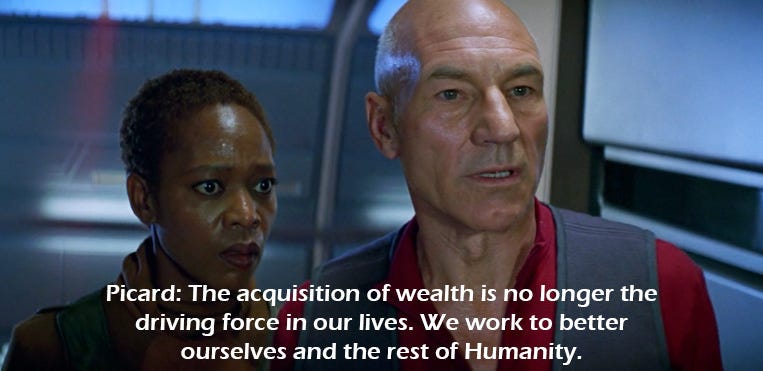Star Trek Transporters are Murder Machines and Here’s Why I’d Use One
Transporters are Murder Machines
Transporters allow a person in Star Trek to travel between two locations in a couple seconds. Seems like magic, but the technology it uses is actually conceivable. It would only require a super advanced MRI scanner and a super advanced 3d printer. You are scanned, disassembled molecule by molecule, and then reassembled at the destination. Even though it is the safest form of transportation in Star Trek there are a handful of characters on the show who are hesitant to use it and prefer using shuttle crafts. But they are only worried about the possibility of something going wrong.
There is also the fear that even when the transporter works perfectly you still don’t survive the trip. This is the idea that it isn’t the same person at the destination, it is only a clone or replica and everyone just believes otherwise. Even the replica believes they were the original person since they have all their memories and continue to behave the same way. This replica fear is only mentioned in passing once in the entire franchise, by the inventor of the transporter, Dr. Erickson.
Star Trek Enterprise Season 4 Episode 10:
That’s it, he just brushed aside the question as silly metaphysical chatter. But here’s a transporter malfunction that will never be in a trek episode because even Erickson couldn’t ignore it. So, there’s a forcefield in a cargo bay that they can’t get rid of. And they need to beam someone from one side of the cargo bay to the other. The transporter scans them and materializes them on the other side of the force field, but the original is still there. There was a malfunction and the transporter did the reassembly but not the disassembly.
The first person anticipated experiencing the future of the second person, but now they are looking at each other. And the first person is still experiencing their point of view, not the person’s at the destination. This plainly shows that transporters don’t work, they don’t let you travel instantaneously, they just kill you and make a clone.
It is usually at this point in the conversation when trekkies start referencing various technobabble phrases from different episodes. So let’s take a closer look at the rules of the Star Trek universe.
Writer’s technical manual
The Star Trek Technical Manual was published in 1991. It goes over all the details of how technology on the show works. This book’s release was actually rushed because someone had leaked an internal document from the show the year before. The internal document was only meant to be seen by writers for the show. The official one is written from an in-universe perspective by members of Starfleet. But the leaked one is written from the perspective of the writers for the other writers so it’s much more direct. They even referenced the leaked manual in the one sold in stores.
“An important word of caution: All Starfleet personnel are hereby advised that any previous technical documentation in your possession may be suspect because of an ongoing Starfleet program of disinformation intended to confound and confuse the intelligence assets”
But I think the official book does more to confound and confuse than the leaked one. These guides are supposed to provide a consistent answer to technical questions. But in the show itself the rules of the transporter aren’t consistent. They work differently in certain episodes just because the story requires it. So there really isn’t one canonical explanation for how it works. But these manuals are at least the default explanation. Which the writers are free to ignore so they can make a Tuvix, or a second Riker, or a good and bad Kirk, or have Scotty come back for an episode of TNG.
In the writers’ manual, it describes the difference between replicating food and transporting a person. To replicate food it is fine to have a pattern stored with detail down to merely the molecular level. But that isn’t good enough for living matter for some reason, for transporting people it needs to be at a “quantum-level resolution.” And all that data down to the position and motion of electrons would be way too big of a file even for 24th century computers to save. The spaceships have enough memory to process the data but not enough to store it.
The analogy they use to explain this really gives away that this was written around 1990, 7 years before DVDs were invented. They compared the futuristic technology to TVs and VHS tapes. In 1990 you could watch a TV show with good resolution, but once it was recorded it would be much worse quality. So if you tried to resurrect someone with a molecular level scan they would come back looking like an old VHS tape.
This is the convenient excuse the writers have for why they can’t just kill off a character and bring them back with the transporter for the next episode. It would be possible to reincarnate people, but only if they had a lot more data storage. If you were able to resurrect your crewmate then the transporter would seem more like a suicide machine taped to a cloner. The writers aren’t trying to be scientifically accurate. They just want to move the story along so they throw some technobabble at the audience until they submit.
If someone asked Dr. Erickson, inventor of the transporter, why they shouldn’t be worried about surviving a transport he might say, “Don’t worry we have compensated for all the quantum and energy states of all the electrons shells, and the Brownian motions of every sub-atomic particle of every atom.” Which doesn’t explain anything, but does succeed in making you want to use the transporter just to get out of the conversation.
But I wouldn’t need to be bullied by technobabble to use a transporter. Here’s where I finally explain the second part of the title of this video, why I’d still use a transporter anyway.
Dr. Erickson, Or: How I Learned to Stop Worrying and Love the Transporter
We’ve already gone over why you have no reason to anticipate experiencing the future after being transported. But here’s a much bolder claim, normal survival is just as bad as being transported. Any reason you can give for why you expect to experience your future normally can also be said about the transported replica. Both future-you and the replica have your memories, your behavior patterns, and usually even your individual molecules. So if you aren’t worried about surviving moment to moment, you shouldn’t have to worry about surviving the transporter.
The moral philosopher Derek Parfit called this, the Extreme Claim. “My relation to my Replica gives me no reason for special concern. Since ordinary survival is no better, it too gives me no such reason.” This is a pretty weird idea to wrap your head around, so let me explain with another Star Trek scene that would never happen on the show. This scene is based on the thought experiment of another English moral philosopher, Bernard Williams.
A member of Starfleet was exposed to radiation. Thankfully though they caught it early, they only need to replace one neuron in the brain. They will use the transporter to lock on to the damaged neuron, beam it away, and then instantly replace it with a new undamaged neuron. It is only one neuron so you’ll definitely survive the surgery. It’s less than the number of neurons killed by a mild concussion. And people anticipate experiencing the future after having one of those.
There is a problem though with the radiation damage. There is no way of knowing which neuron is the damaged one. And as time goes by the damage will spread. So the doctor recommends a surgery where a percentage of the brain is replaced. What percentage of the original brain needs to stay for you to survive the surgery? If one neuron was an acceptable loss, why not 10% of the brain? 25%? At what percentage would you not experience the future after the surgery? Say you decide on 50%, what’s the argument against 51%? 52%? All the way up to 99%? You are eventually just left with one original neuron. And there’s no way our consciousness is housed in one neuron. Anticipation of the future doesn’t work on a sliding scale, it’s all or nothing. You can’t half experience a moment, or experience it 75%.
Here’s the point of the thought experiment. It is impossible to answer the question because of an assumption in the way it was asked. The question assumes you should anticipate experiencing the future to begin with. Once you give up that assumption, then the question becomes solvable. The transporter is fine to use, there is no reason to anticipate experiencing the future normally, so there’s nothing to lose by using the transporter. And what you gain by transporting is letting future-you not have to waste time on the shuttle craft.
When I started thinking about this idea it really confused me. Philosophical ideas and thought experiments are interesting, but they leave me with specific questions I want answered by the other sciences, like Neuroscience and Evolutionary Biology.
How is the brain organized? And where is the central control center of the brain? I tried to answer these questions in my previous post. To briefly summarize, there isn’t one executive part of the brain where the “you” that will experience the future lives. It is an ever changing mix of different processes that believes it is one permanent self.
There’s also the biology question of how this anticipation of the future evolved. Why would we evolve to think like this if that’s not how our brains actually work? I tried to answer these questions in my first post so I’d recommend checking that out if you are curious. The post also tries to answer the question, “What am I supposed to do about it?” Spoiler alert: it isn’t nihilism and hedonism so don’t worry, this isn’t that kind of blog.
If it seems impossible to make sense of life without this anticipation of the future just remember that it also seems impossible to live without money. But they manage without it in Star Trek.
Star Trek: First Contact
Same is true for the self. We don’t need to banish the self or money. But once they aren't driving forces in our lives, we can work to better our future selves and the rest of humanity too.









